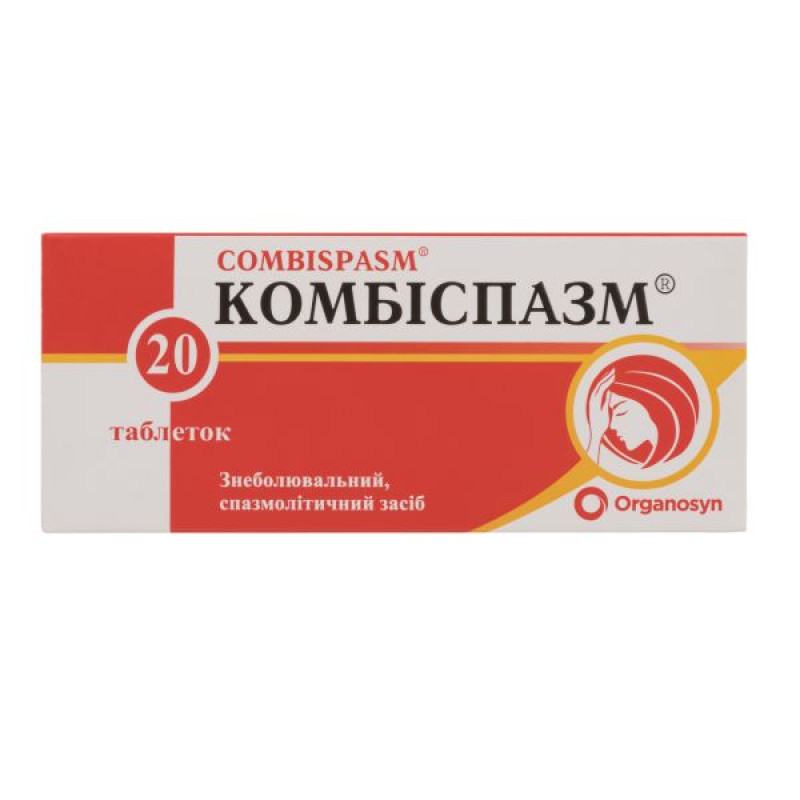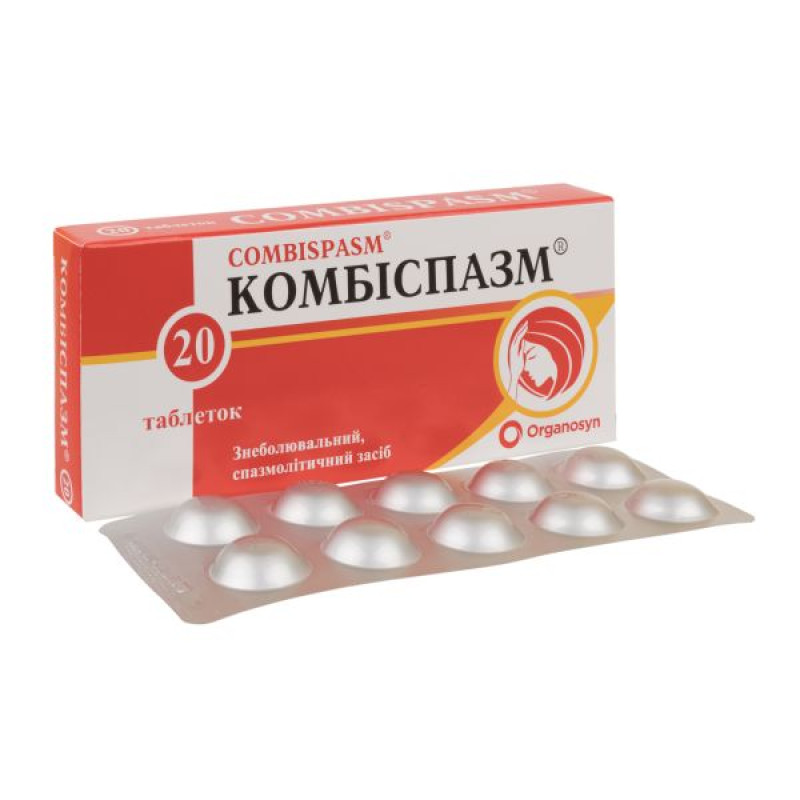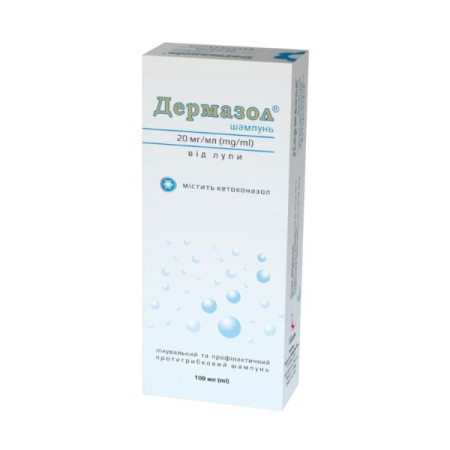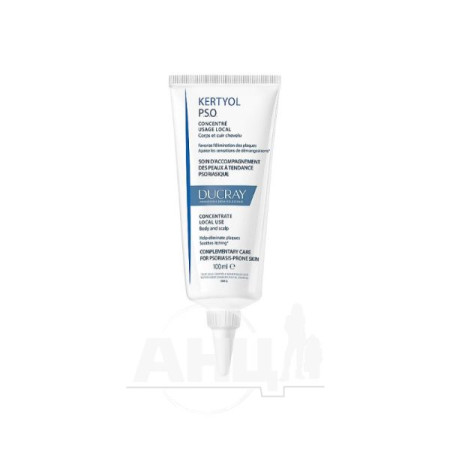Combispasm tablets blister No. 20
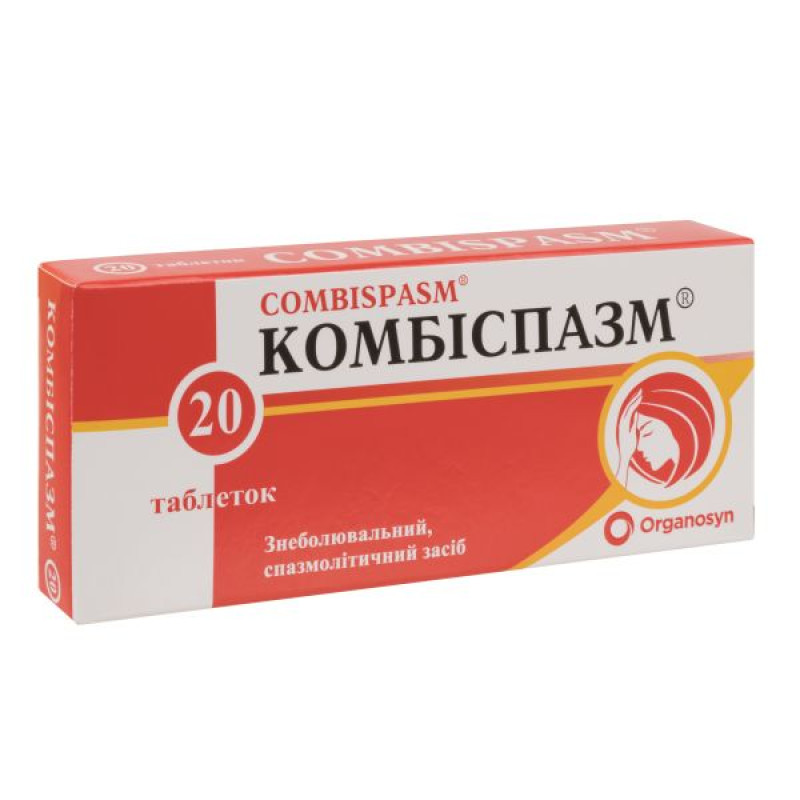
Instructions for use Combispasm tablets blister pack No. 20
Composition
active ingredients: paracetamol, dicyclomine hydrochloride;
1 tablet contains paracetamol 500 mg, dicyclomine hydrochloride 20 mg;
Excipients: corn starch, microcrystalline methylcellulose, povidone, magnesium stearate, talc, colloidal anhydrous silicon dioxide, sodium starch glycolate (type A).
Dosage form
Pills.
Main physicochemical properties: tablets without a shell, white in color, round in shape with a score.
Pharmacotherapeutic group
Analgesics and antipyretics. Paracetamol, combinations without psycholeptics.
ATX code N02B E51.
Pharmacological properties
Pharmacodynamics
A combined drug that has analgesic and antispasmodic effects.
Paracetamol acts as an analgesic and antipyretic. The analgesic and antipyretic effects of paracetamol (a non-opiate, non-salicylate analgesic) are associated with the drug's effect on the thermoregulatory center in the hypothalamus and its ability to inhibit prostaglandin synthesis.
Dicyclomine hydrochloride is a tertiary amine. It has anticholinergic activity and reduces smooth muscle tone, eliminates pain, blocks antagonistic activity. Dicyclomine hydrochloride selectively paralyzes M-cholinergic structures, blocking the transmission of impulses from postganglionic cholinergic nerves to the effector organs innervated by them. Causes relaxation of smooth muscles, exhibiting an antispasmodic effect in spasms of smooth muscles of the stomach, intestines, biliary tract, urogenital and vascular systems.
Pharmacokinetics
Paracetamol is well absorbed from the gastrointestinal tract, peak plasma concentrations are reached within 30 minutes to 2 hours after administration.
When administered orally, dicyclomine is rapidly absorbed from the gastrointestinal tract and reaches peak concentrations within 60–90 minutes. The main route of excretion is via the urine.
Indication
Pain syndromes with a spastic component of various origins:
headache; toothache; muscle pain, neuralgia; rheumatic pain, radiculitis; renal colic; menstrual pain.
Contraindication
Hypersensitivity to the components of the drug. Glaucoma, tachycardia, urinary tract obstruction, benign prostatic hypertrophy with a tendency to urinary retention, severe renal and/or hepatic dysfunction, glucose-6-phosphate dehydrogenase deficiency, alcoholism, blood diseases, anemia (including hemolytic), leukopenia. Dynamic intestinal obstruction, paralytic intestinal obstruction, pyloric stenosis of the gastrointestinal tract with obstruction, severe ulcerative colitis, obstructive diseases of the gastrointestinal tract and biliary tract with impaired patency, peptic ulcer of the stomach or duodenum, reflux esophagitis; acute bleeding; congenital hyperbilirubinemia (Gilbert, Dubin-Johnson and Rotor syndromes), myasthenia gravis, thyrotoxicosis, heart failure.
Interaction with other medicinal products and other types of interactions
The interaction features of the drug are due to the properties of its components.
Paracetamol, which is part of the drug, reduces the effectiveness of diuretics.
Simultaneous use of paracetamol with anticonvulsants (barbiturates, phenytoin, carbamazepine), rifampicin, which stimulate the activity of liver microsomal enzymes, may increase the toxic effect of paracetamol on the liver due to an increase in the degree of conversion of the drug to hepatotoxic metabolites. Simultaneous use of high doses of paracetamol with isoniazid increases the risk of developing hepatotoxic syndrome. With simultaneous use of paracetamol with hepatotoxic drugs, the toxic effect of drugs on the liver increases. Do not use simultaneously with alcohol.
Barbiturates reduce the antipyretic effect.
The rate of absorption of paracetamol may increase when used concomitantly with metoclopramide and domperidone and decrease when used concomitantly with cholestyramine.
The effect of paracetamol is enhanced when combined with codeine, ascorbic acid, scopolamine, chlorphenamine, propyphenazone, and caffeine.
Concomitant use of paracetamol with azidothymidine may lead to the development of neutropenia.
The anticoagulant effect of warfarin and other coumarins is enhanced by long-term regular use of paracetamol, and the risk of bleeding also increases. Periodic administration has no significant effect.
The simultaneous use of paracetamol with nonsteroidal anti-inflammatory drugs increases the risk of kidney complications.
Dicyclomine hydrochloride may enhance the effects of monoamine oxidase inhibitors (imipramine, amitriptyline), sedatives (sodium bromide, valerian tincture), and ethyl alcohol.
Since antacids may reduce the absorption of dicyclomine hydrochloride, their concomitant use should be avoided.
Dicyclomine hydrochloride reduces the effect of metoclopramide when used simultaneously.
The inhibitory effect of dicyclomine on gastric acid secretion may neutralize drugs used to treat achlorhydria and study gastric secretion.
Dicyclomine hydrochloride enhances the effects of digoxin and anticholinergics. The simultaneous use of dicyclomine with other anticholinergics is not recommended.
Dicyclomine hydrochloride may affect the gastrointestinal absorption of various prolonged-release drugs, such as digoxin, which may lead to an increase in the concentration of the latter in the urine.
The drug enhances the effect of salicylic acid, pyrazolone, codeine, caffeine. Potentiates the effect of antispasmodics.
Dicyclomine hydrochloride reduces the effect of antiglaucoma drugs, so the drug should be prescribed with caution in cases of increased intraocular pressure and simultaneous use of corticosteroids.
Application features
Due to the fact that the composition includes paracetamol, when using the drug, monitoring of the peripheral blood picture and the functional state of the liver is required.
The product contains paracetamol, so it should not be used together with other products containing paracetamol and used, for example, to reduce fever, treat pain, flu and cold symptoms or insomnia. Simultaneous use with other products containing paracetamol may lead to overdose. Overdose of paracetamol can cause liver failure, which may require a liver transplant or be fatal.
Do not exceed the indicated doses.
If the symptoms of the disease do not disappear, consult a doctor.
Patients who regularly take analgesics for mild arthritis should consult a doctor before using the drug.
Use of the drug for more than 3 days requires mandatory medical supervision.
If you develop a persistent headache, you should consult a doctor.
It should be noted that patients with liver disease are at increased risk of hepatotoxicity of paracetamol; the drug may affect the results of laboratory tests for blood glucose and uric acid.
It should be used with caution in elderly patients. When prescribing to elderly people, no correction of the dosage regimen is required. Prescribe with caution in the presence of difficulty urinating, prostatic hyperplasia without urinary retention, ulcerative colitis, kidney or liver disease; consult a doctor before use.
Cases of liver dysfunction/liver failure have been reported in patients with reduced glutathione levels, such as those with severe wasting, anorexia, low body mass index, or chronic alcoholism.
Patients with reduced glutathione levels, for example those with severe infections such as sepsis, are at increased risk of metabolic acidosis when taking paracetamol. Symptoms of metabolic acidosis include deep, rapid or difficult breathing, nausea, vomiting, loss of appetite. You should seek medical attention immediately if these symptoms occur.
Dicyclomine hydrochloride may increase gastroesophageal reflux.
The drug should be prescribed with caution to patients with autonomic neuropathy, arterial hypertension, ischemic heart disease with tachyarrhythmias, tachycardia, a tendency to bronchospasm, as well as with increased individual sensitivity to nonsteroidal anti-inflammatory drugs.
It should be noted that patients taking anticholinergic drugs, including dicyclomine, may experience psychosis, confusion, disorientation, ataxia, coma, euphoria, weakness, insomnia, agitation, inadequate emotional manifestations, and affective state (symptoms decrease within 12–24 hours after dose reduction).
Dicyclomine should be prescribed with caution in cases of hiatal hernia accompanied by reflux esophagitis.
At high ambient temperatures, dicyclomine hydrochloride, by reducing sweating, causes an increase in body temperature with the risk of heat stroke. If appropriate symptoms appear, it is necessary to discontinue use of the drug and consult a doctor.
Before using the drug, it is necessary to consult a doctor if the patient is using warfarin or similar drugs that have an anticoagulant effect.
Ability to influence reaction speed when driving vehicles or other mechanisms
Since dicyclomine hydrochloride may cause adverse reactions from the nervous system and visual organs, when using the drug, you should refrain from driving vehicles and working with other mechanisms.
Use during pregnancy or breastfeeding
The drug is not recommended for women during pregnancy and breastfeeding.
Method of administration and doses
Adults: 1–2 tablets depending on the severity of the pain 1–4 times a day. When treating adults, it is advisable to start with 4 tablets per day. The maximum dose can be increased to 8 tablets per day, provided that it is well tolerated and there are no side effects.
The duration of treatment should be determined individually, depending on the patient's condition and response. If the effectiveness of treatment is not achieved within 2 weeks or there are signs of side effects at a dose of less than 4 tablets per day, the drug should be discontinued.
Children aged 7 to 13 years: ½ tablet 1–2 times a day; aged 13 to 15 years: 1 tablet 1–3 times a day; aged 15 years and over: 1–2 tablets depending on the severity of the pain 1–4 times a day.
Children
The drug should not be prescribed to children under 7 years of age.
Overdose
Symptoms of overdose are due to the properties of the individual components of Combispasm.
Symptoms of overdose.
Paracetamol. Liver damage is possible in adults who have taken 10 g or more of paracetamol, and in children who have taken more than 150 mg/kg of body weight. The risk of paracetamol overdose is higher in patients with non-cirrhotic alcoholic liver disease. In patients with risk factors (long-term treatment with carbamazepine, phenobarbital, phenytoin, primidone, rifampicin, St. John's wort or other drugs that induce liver enzymes; regular intake of excessive amounts of ethanol; glutathione cachexia (digestive disorders, cystic fibrosis, HIV infection, starvation and cachexia), taking 5 g or more of paracetamol can cause severe liver damage.
Symptoms of overdose in the first 24 hours: pallor of the skin, anorexia, nausea, vomiting, diarrhea, feeling of discomfort in the epigastric region (lasting up to 1 day), abdominal pain. Liver damage may become apparent 12–48 hours after overdose. Disorders of glucose metabolism and metabolic acidosis may occur.
The following symptoms may be observed: increased activity of hepatic transaminases, lactate dehydrogenase, bilirubin levels, as well as a decrease in prothrombin levels (duration from 1 to 2 days); hepatotoxic effect, which is characterized by general symptoms (pain, weakness, adynamia) and specific (hepatomegaly, jaundice, increased activity of liver enzymes) symptoms.
In severe poisoning, liver failure may progress to hepatic encephalopathy (impaired thinking, depression of higher nervous activity, agitation and stupor), DIC, hypoglycemia, hemorrhages, arrhythmias, seizures, respiratory depression, coma, cerebral edema, hypocoagulation, collapse and lead to death. Occasionally, liver failure develops rapidly and may be complicated by renal failure.
Acute renal failure with acute tubular necrosis may present with severe back pain, hematuria, and proteinuria, and may occur even in the absence of severe liver damage. Cardiac arrhythmias and acute pancreatitis, usually accompanied by liver dysfunction and hepatotoxicity, have been reported.
With prolonged use of the drug in high doses, aplastic anemia, pancytopenia, agranulocytosis, neutropenia, leukopenia, and thrombocytopenia may develop on the part of the hematopoietic organs.
When taking large doses, from the central nervous system - dizziness, psychomotor agitation and disorientation; from the urinary system - nephrotoxicity (renal colic, interstitial nephritis, capillary necrosis).
Dicyclomine hydrochloride. Tachycardia, bradycardia, arrhythmia, change in respiratory rate, dry mouth, agitation, drowsiness, loss of accommodation, photophobia, convulsions, dry skin and mucous membranes, increased intraocular pressure, headache, dizziness, excitation of the central nervous system, urinary retention, psychomotor agitation, disorientation.
Overdose develops in two stages: first, there is excitation of the central nervous system, which is manifested by anxiety, hallucinations, the occurrence of persistent mydriasis, tachycardia, and arterial hypertension. Then, the excitation is replaced by a phase of central nervous system depression up to a comatose state.
In the first hours (up to 1 day) there is pale skin, nausea, anorexia, vomiting and abdominal pain. During the second-third day, kidney and liver damage may develop with the development of liver failure (increased activity of hepatic transaminases, dehydrogenase, increased concentration of bilirubin, prothrombin), as well as tachycardia, arrhythmias; change in respiratory rate, pancreatitis.
Treatment.
Symptoms may be limited to nausea and vomiting or may not reflect the severity of the overdose or the risk of organ damage. Gastric lavage, use of activated charcoal (if the overdose of paracetamol was taken within 1 hour). Paracetamol concentration should be measured 4 hours or later after ingestion (earlier concentrations are unreliable). Treatment with N-acetylcysteine can be used within 24 hours of ingestion, but the maximum protective effect occurs when it is used within 8 hours of ingestion under the control of the respiratory and circulatory systems (adrenaline should not be used). The effectiveness of the antidote decreases sharply after this time. In case of convulsions, diazepam is prescribed. If necessary, the patient should be given N-acetylcysteine intravenously, according to current recommendations. In the absence of vomiting, oral methionine can be used as a suitable alternative in remote areas outside the hospital.
There is no specific antidote to dicyclomine hydrochloride.
If necessary, symptomatic therapy and peritoneal dialysis should be performed.
General supportive measures should also be taken.
Adverse reactions
The drug is usually well tolerated. Side effects associated with the active substances included in the drug appear, as a rule, with prolonged use of the drug in high doses.
Paracetamol.
From the digestive tract: nausea, vomiting, decreased appetite, constipation, diarrhea or flatulence. With prolonged use of high doses of the drug - pain in the epigastric region.
From the liver and biliary tract: increased activity of liver enzymes, usually without the development of jaundice, impaired liver function, hepatonecrosis (dose-dependent effect), hepatotoxic effect.
On the part of the endocrine system: hypoglycemia (up to hypoglycemic coma).
From the blood and lymphatic system: hemolytic anemia, thrombocytopenia; aplastic anemia, pancytopenia, sulfhemoglobinemia and methemoglobinemia (cyanosis, shortness of breath, heart pain), neutropenia, agranulocytosis, leukopenia, bruising, bleeding.
From the urinary system: difficulty urinating, renal colic, aseptic pyuria, interstitial glomerulonephritis; nephrotoxic effect, papillary necrosis.
On the part of the immune system: hypersensitivity reactions, allergic reactions, including skin rash, rash on the mucous membranes, itching, urticaria, hyperemia, bronchial obstruction, erythema multiforme exudative (Stevens-Johnson syndrome), toxic epidermal necrolysis (Lyell's syndrome), anaphylaxis, generalized rash, angioedema, angioedema, erythematous rash.
Respiratory and thoracic disorders: bronchospasm in patients sensitive to aspirin and other nonsteroidal anti-inflammatory drugs.
From the side of the central nervous system and psyche (usually observed when taking high doses): dizziness, psychomotor agitation and disorientation, tinnitus, psychosis, coma.
Others: general weakness.
Dicyclomine hydrochloride.
Skin and subcutaneous tissue disorders: rash, pruritus, urticaria, severe allergic reactions or drug idiosyncrasy, including anaphylaxis.
On the part of the digestive tract: dry mouth, thirst, taste disturbances, digestive disorders, anorexia, nausea, vomiting, flatulence, constipation, abdominal pain.
On the part of the organs of vision: blurred vision, diplopia, mydriasis, cycloplegia of vision (paralysis of accommodation), increased intraocular pressure.
From the side of the central nervous system and psyche: dizziness, fatigue, impaired sensitivity, impaired gait stability, dyskinesia, tingling sensation, numbness in the extremities, tinnitus, headache, dysphasia, dysarthria, ataxia, euphoria, inadequate emotional reactions (symptoms decrease 12–24 hours after dose reduction), insomnia, drowsiness, hallucinations, general weakness, mood changes, nervousness, disorientation, short-term memory loss, psychosis, confusion and/or agitation, dyskinesia, lethargy, loss of consciousness, coma.
From the cardiovascular system: tachycardia, arrhythmia, palpitations.
Urinary system disorders: urinary incontinence, urinary retention.
Musculoskeletal and connective tissue disorders: muscle weakness.
On the part of the respiratory system and chest organs: dyspnea, apnea, asphyxia, nasal congestion, sneezing, throat hyperemia.
From the endocrine system: suppression of lactation, impotence.
Others: feeling of hot flashes, decreased sweating.
Expiration date
3 years.
Storage conditions
Store in the original packaging at a temperature not exceeding 25 °C.
Keep out of reach of children.
Packaging
10 tablets in a blister, 2 blisters in a cardboard pack.
Vacation category
Without a prescription.
Producer
Evertogen Life Sciences Limited.
Location of the manufacturer and its business address
Plot No.: S-8, S-9, S-13/P and S-14/P T E C I A C, S I Z Pharma, Green Industrial Park, Polepally (V), Yedcherla (M), Mahabubnagar, Telangana, IH-509 301, India.
There are no reviews for this product.
There are no reviews for this product, be the first to leave your review.
No questions about this product, be the first and ask your question.







